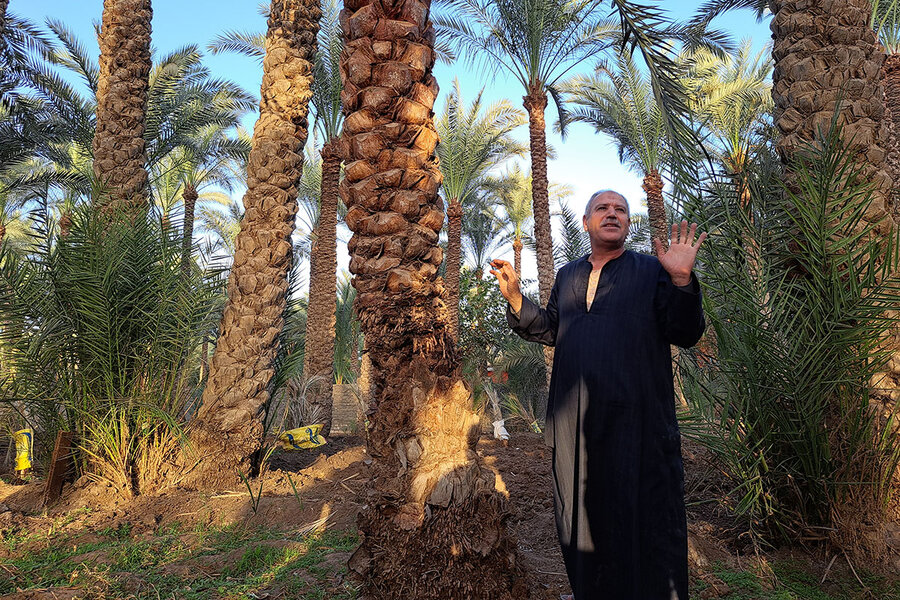In Egypt and beyond, a climate crisis as close as the nearest water tap
Loading...
| Dahshur, Egypt; and Al Koura, Jordan
Amid longer and more frequent droughts, questions that have vexed the Middle East and North Africa for decades are becoming matters of national security: Grow wheat or grow your economy? Water increasingly scorching farms or a thirsty population?
The challenges are prompting a search for fresh solutions, from creating desalination plants to preventing water leakage and evaporation from irrigation canals. At COP27, this year’s global climate action summit in Egypt, the usual headlines about how to curb heat-trapping carbon emissions are joined by a rising focus on how to adapt to climate shifts that are already being felt.
Why We Wrote This
A story focused onWater scarcity is a growing challenge in much of the world – and notably in the Middle East and North Africa region that is now hosting a global climate summit. One big tension: balancing rural and urban priorities.
Despite water scarcity, Egypt is one of several Arab states pushing for greater local production of grains – to overcome a burgeoning food crisis.
“We are the ones that feed you,” says Samayni, an Egyptian farmer who had three straight years of no mango production due to intense heat waves and a lack of water.
Mohammed Fahim, of Egypt’s Central Laboratory for Agricultural Climate, says the way forward is “to conserve our limited water resources through advanced water-saving irrigation practices.”
As world leaders gather for a summit on global warming some 300 miles away, Nile Valley farmer Samayni says he has little time to think about climate change.
Standing among his date and mango groves, with the Black Pyramid of Dahshur looming above, in an area where people have farmed for millennia, as he sees it he is simply struggling to make more with a formerly abundant resource.
“Forget about climate change, rising temperatures, or the ozone – our main problem here is water,” he says, gesturing to a bone-dry irrigation canal near to his farm. While in previous years Nile water would flow down this channel each day, he and other farmers now get irrigation water once every 20 days as part of new allocation rotation.
Why We Wrote This
A story focused onWater scarcity is a growing challenge in much of the world – and notably in the Middle East and North Africa region that is now hosting a global climate summit. One big tension: balancing rural and urban priorities.
“We are struggling to continue with less and less water, and our ability to feed ourselves as a people is in danger.”
Here in the Middle East, home to the most water-stressed countries on Earth, conserving and maximizing water in these arid lines has been a careful balancing act since antiquity.
Yet as longer and more frequent droughts, combined with higher temperatures and delayed and reduced rainfall, push many Middle East and North African states into water crises, questions that have vexed the region for decades are becoming matters of national security: Grow wheat or grow your economy? Water increasingly scorching farms or a thirsty population?
The challenges – which scientists widely attribute to climate change as well as to rising human consumption – are prompting a search for fresh solutions, from desalination plants to preventing water-source leakage and evaporation. And the concern about water supply, though varying from one region to the next, is increasingly global in scale – a fact visible in the agenda of COP27, this year’s global climate action summit in Sharm el-Sheikh, Egypt. The summit’s usual headlines about how to curb heat-trapping carbon emissions are joined by a rising focus on how to adapt to climate shifts that are already being seen and felt.
At the conference, Egypt helped announce the Sharm El-Sheikh Adaptation Agenda which, among other goals, calls for “smart, efficient and robust water systems” with a reduction of water loss through leakage and sustainable irrigation systems to be implemented across 20% of global croplands by 2030 “to preserve water availability whilst supporting yield growth.”
In the Middle East, a balancing act
Nowhere is the pressure to adapt more urgent than in Egypt and other nations in this region, as debt-burdened countries scramble to balance development needs with feeding themselves amid Ukraine war-induced grain shortages.
With over-pumping and evaporation of exposed irrigation canals and dams due to rising temperatures, Egypt now faces a water deficit of 21 billion cubic meters per year, according to the Egyptian government.
Here, 560 cubic meters (150,000 gallons) of water are available per person annually, less than a third of the amount available 50 years ago, according to Egyptian government data. Anything below 1,000 cubic meters per person is defined by the United Nations as water-scarce.
Jordan and Tunisia, which depend solely on rainwater-fed dams and underground water, are facing droughts. Tunisia has less than 400 cubic of meters of water per person annually, and Jordan, less than 90 cubic meters of water per person, making it the second most water-poor country on Earth.
Last month, leading religious authorities in both countries called for national prayers for rain. Jordan received its first full rain of the year on Tuesday.
Scarcity has sparked a debate on where and how water is spent.
In Egypt, 85% of water is reserved for agricultural irrigation, leaving only 15% of water going to urban use, industry, and tourism in the Arab world’s most populous and fastest-growing country.
Egypt is one of several Arab states that are pushing for greater production of local grains – to overcome a burgeoning food crisis and reliance on Ukraine and Russia – even as their water sources dry up.
Farmer Samayni, who had three straight years of no mango production due to intense heat waves and a lack of water, says the priorities are clear.
“You need to put agriculture first. Agriculture should steer the country. We are the ones that feed you, we are the ones that keep the nation together,” he says, “If you don’t water us, we will starve.”
Yet the priority on agriculture has meant more water shortages for villages and cities.
“You think twice about taking a shower”
In Jordan, when a town expands, authorities are often unable or unwilling to extend government-provided water, leaving new homes to rely on private wells.
Abu Tareq Al Moqdadi, imam of a local mosque next to a cave locals believe Jesus visited, and his family of seven have relied solely on trucked-in water at $50 to $80 a month since they built a home on his father’s land at the outskirts of the northern Jordanian village of Bayt Idis seven years ago.
Despite government promises and a U.N.-supported program to expand the network to reach this fast-growing neighborhood, they, like many in northern Jordan, remain without water.
“You think twice about taking a shower, doing laundry, how you do dishes,” Mr. Al Moqdadi says. “Water has become the largest cost and biggest challenge in our daily lives. It brings everything to a halt.”
In Dhiban, an agricultural town in central Jordan, 50 miles south of Amman, the 35 million cubic meter Mujib reservoir has been dry since April.
“You are constantly under climate stress because you don’t know where the next cup will come from,” says Mohammed Hameida, who works with local youths in Dhiban. He and many residents now rely on private wells. “I am afraid for my children. How will they live?”
Back in Egypt, at a small filtration plant in Dahshur, residents line up to fill large plastic containers with filtered groundwater.
With the limited Nile water and reduced water quality due to agricultural runoff, what was once an anomaly and a luxury – filtered water – has become the main source for household use in this village and many others across Egypt in recent years.
Yet these underground resources are projected to be depleted far faster than they regenerate, water experts say.
“The main principle promoted by water advocates for decades is to stop allocating water for agriculture. When you do that you can free it up for other economic sectors that have more value – whether tourism, industry, even financial services,” says Guy Jobbins, a research associate at the Climate and Sustainability Programme at ODI in London and Middle East water policy expert.
“The problem is, in these dry and hot countries water is needed for agriculture which still employs a lot of people,” Dr. Jobbins says, “If you take water out of farmlands and reallocate for cities, then all of a sudden you have real problems for rural poverty. And then there is the issue of food security.”
A rising focus on solutions
For Egypt, one answer to its water woes is an ongoing national project to line irrigation channels with cement to reduce water loss and improve water quality. Another pilot project is completely covering water canals in the Upper Nile Delta to prevent evaporation.
Since 2020, Egypt has lined more than 4,500 km (2,800 miles) of irrigation channels, with plans to line a total of 20,000 km by mid-2024, according to its Irrigation Ministry, a project projected to save up to 5 billion cubic meters in water loss annually due to seepage.
Dozens of cranes and crews dig up mud along canals running parallel to the Nile south of Cairo, expanding the project.
“The only way forward are programs to boost agricultural production on existing lands with the same amount of water and to conserve our limited water resources through advanced water-saving irrigation practices,” says Mohammed Fahim, of Egypt’s Central Laboratory for Agricultural Climate.
“But unfortunately, these measures are very costly and require advanced technology and funds. As of now, Egypt and other Arab states are relying solely on their national budgets, which cannot possibly fund these projects on their own.”
Egypt, which is holding the presidency of COP27 as host, is set to announce a water initiative next week, as the global climate conference continues.
Jordan, meanwhile, is exploring a project to build a desalination plant on its sole sea port of Aqaba to pump water 200 miles uphill to the capital Amman, where half of its citizens live. That would add 250 million to 300 million cubic meters of desalinated water a year, and would cover about half its projected annual deficit.
On Tuesday, Jordan and Israel moved closer toward a water-for-solar energy deal. Under the agreement, brokered by the UAE last year and signed by the two countries this week, Israel will provide Jordan with 200 million cubic meters of desalinated water in return for 600 megawatts of solar-generated electricity annually.
Yet Jordan, Tunisia, and Egypt are all burdened with billions in international debt and struggle to keep pace with growing demand on overstressed government services.
“The developed countries whose industrial development caused the climate change we are living with must pay reparations so that other nations can survive and adapt,” says Mr. Fahim, the Egyptian climate expert, “because the climate crisis will not stay in the borders of one country.”
As the sun sets over palm-shaded farms in the Al Qalyubia governorate north of Cairo, tenant farmers Mohamed Awadh and his wife Soumaya have plenty of worries – notably the rising costs of fertilizer and salts.
“God’s blessings,” Soumaya says over the roar of the diesel pump. “That will dictate whether we have a good harvest or not.”
But they express gratitude and satisfaction over the cleaner water provided by the Egyptian canal project. And it is making a visible difference, seen as they flood their acre plot of mint and cauliflower with Nile water pumped from a newly paved canal a few feet away.











